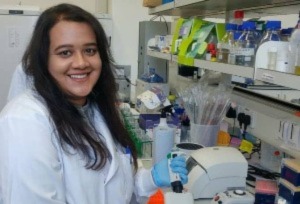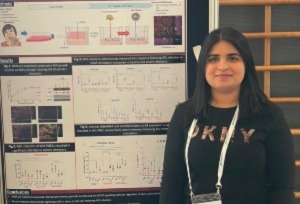Most Promising Science Poster Prize 2022: Journal of General Virology
Posted on July 29, 2022 by Microbiology Society
Throughout Annual Conference 2022, delegates showcased excellent posters and exciting research. The Microbiology Society Journals ‘Most Promising Science’ prizes were awarded by Journal of General Virology Editors. In this blog, we meet the winners to find out more about them and their research.
Nazia Thakur: 'SARS-CoV-2 variants of concern have extended mammalian ACE2 receptor host-range'

Who or what inspired you to become a scientist?
I think the teaching I received during the final year of my undergraduate degree inspired me to become a scientist. I also really enjoyed my first lab experience; seeing the knowledge, passion, and dedication of my supervisor to their work really stuck with me and made me want to continue doing research.
What are you currently working on and what area of your research excites you the most?
I started my PhD in September 2020 and my research question focuses on determining whether pre-existing immunity can confer cross-protection against infection from related viruses (henipaviruses and coronaviruses). Being able to combine both my love for immunology and virology really excites!
How would you explain your poster to a child under 10?
We were trying to look at whether SARS-CoV-2, the virus that causes COVID-19, can infect other animals and whether the infection pattern changes with different SARS-CoV-2 variants. This is important because these animals could get sick or pass the virus back to humans. As SARS-CoV-2 is thought to have originated in bats, we also wanted to see what changes in the virus may have allowed it to infect humans.
What would you be doing in your career if you weren’t a scientist?
I really enjoy doing creative things like drawing, painting, baking and art and crafts in my spare time, so I think I’d probably have enjoyed being a baker and decorator! The lab I’m currently working with are basically the chief tasters of my bakes – no complaints so far!
Sheerien Manzoor: ‘Responses of pediatric airway epithelium to viral and/or aeroallergens in health and disease’

Who or what inspired you to become a scientist?
As I am the first woman in my family to have ever done a PhD and become a scientist, most of it has been self-directed. However, my research venture during my undergraduate studies in Reno, Nevada, USA was one of the defining moments that inspired me to pursue science and research further.
What are you currently working on and what area of your research excites you the most?
Recently I started working as a Postdoctoral Research Fellow at Queens University Belfast, UK exploring potential therapeutic options (antiviral and anti-inflammatory) for SARS-COV-2, using a well-differentiated airway epithelial cell model.
How would you explain your poster to a child under 10?
We are a big group of scientists who are trying to understand why some children’s lungs become so sick when infected with nasty bugs and viruses and how we can keep them healthy for life. So, in my poster, I show some of the reasons that kids can become very sick and find it difficult to breathe (i.e. wheezy) and how our research will help prevent this from happening in the future.
What would you be doing in your career if you weren’t a scientist?
I would have been an artist. I always had a great passion for sketch art, clay art, and natural objects. My biggest inspiration for art was nature and marine life. I loved art so much that I was top of the year during my GCSE studies.

